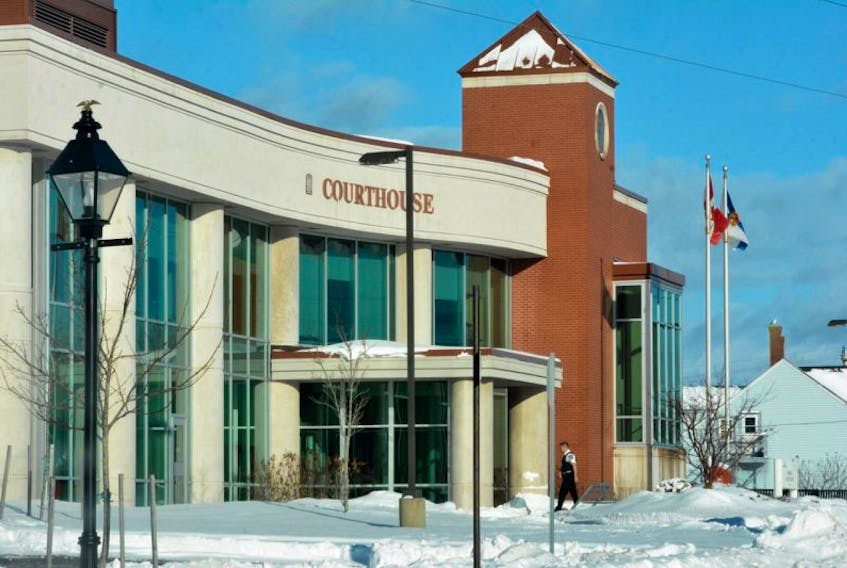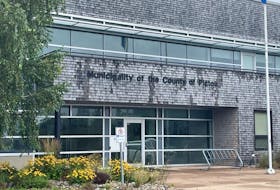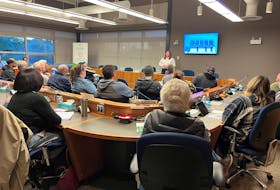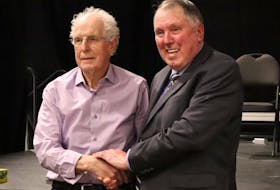But, in delivering his verdict in Supreme Court in Yarmouth on Jan. 10, Justice Pierre Muise sided mostly with the defendant and found Bill Douglas Williams, 51, not guilty of dangerous operation of a vehicle, criminal negligence causing bodily harm and assault with a weapon.
Muise said during the trial there were inconsistencies from all witnesses. But in his decision he concluded that Williams’ version “is the clearest, most coherent and most consistent in the totality of the evidence and seems to make the most sense.”
Williams admitted to hitting the two men – Cade Benham, then 19, and Steven Davis, then 21 – with his vehicle, but the defence’s position was that he was unable to avoid them after they darted out in front of his vehicle.
At the trial, Davis testified that Williams had intentionally swerved towards him and Benham – presumably an act of retaliation after they had assaulted Williams’ son at a Halloween party earlier that night. (The two men were later charged for that assault.)
“I remember a car slowing down and assuming they were going to give a drive, but then I woke up in the hospital staring at my family,” Davis testified last month.
Benham wasn’t able to recall the specific incident on Highway 103 when he testified at the trial in December.
Both men had to be treated at hospital for their injuries.
But, in delivering his verdict in Supreme Court in Yarmouth on Jan. 10, Justice Pierre Muise sided mostly with the defendant and found Bill Douglas Williams, 51, not guilty of dangerous operation of a vehicle, criminal negligence causing bodily harm and assault with a weapon.
Muise said during the trial there were inconsistencies from all witnesses. But in his decision he concluded that Williams’ version “is the clearest, most coherent and most consistent in the totality of the evidence and seems to make the most sense.”
Williams admitted to hitting the two men – Cade Benham, then 19, and Steven Davis, then 21 – with his vehicle, but the defence’s position was that he was unable to avoid them after they darted out in front of his vehicle.
At the trial, Davis testified that Williams had intentionally swerved towards him and Benham – presumably an act of retaliation after they had assaulted Williams’ son at a Halloween party earlier that night. (The two men were later charged for that assault.)
“I remember a car slowing down and assuming they were going to give a drive, but then I woke up in the hospital staring at my family,” Davis testified last month.
Benham wasn’t able to recall the specific incident on Highway 103 when he testified at the trial in December.
Both men had to be treated at hospital for their injuries.

COMMOTION AFTER VERDICT
Following the acquittals, those sitting with Williams displayed relief, while two others in the courtroom expressed anger, verbally lashing out at Williams before being pushed out of the courtroom by the sheriff and deputies.
Muise spent over an hour delivering his verdict, highlighting the inconsistencies among witnesses and also between some of the evidence given at trial and at the preliminary inquiry.
He called the trial testimony of witness Billy Hardy “unreliable.” Muise said Hardy had testified that Williams had told him he intended to find the boys to beat them up. Williams’ maintains he never told Hardy he would beat up the boys. Under cross-examination, Muise noted that Hardy agreed Williams hadn’t used those specific words and said he may have put his own spin on the defendant’s intentions. Muise said he had to reject Hardy’s evidence.
Muise said there were also questions with timelines outlined by other witnesses, including Tim Hortons employees, concerning when they had interactions with Williams in comparison to placed 911 calls.
POLICE WERE COMING
In the early morning hours of Nov. 1, Williams, the justice said, knew the police were on their way to deal with an assault complaint involving his son.
“In my view it would not make sense that (Williams) would deliberately engage in any activity that he knew to be criminal,” Muise said, since he knew the police were en route.

Muise ruled there was no evidence to support the Crown’s assertion that Williams had “hunted” the boys that night, even though he went looking for them on Highway 103 after seeing them underneath a highway overpass on the Welshtown road a short time earlier. If Williams had wanted to run them down, Muise said, he would have had the opportunity to do so then.
Davis had testified that a car had swerved at them as they had walked on that road and that at one point there had been a confrontation involving Williams and his son. Davis said he and Benham climbed a hill to go up to the highway.
Justice Muise said he accepted defence evidence that Williams went looking for the boys on Highway 103 to keep them in sight to ensure they would not evade the police.
Because Williams had not been drinking that night, Muise ruled his recollection of events would be reliable. The justice expressed concern over the reliability of the testimony of the two young men, saying they had been drinking at the party, were intoxicated and had done drugs during the day.
Muise didn’t assign fault for the two young men being hit, saying the two could have easily misjudged the distance and speed of an approaching vehicle on Highway 103 when they attempted to cross the highway.
CROWN ARGUMENTS
The Crown’s case was that the two men had been struck intentionally. The Crown had argued that two men had not just appeared quickly out of nowhere, leaving Williams unable to avoid them. Justice Muise, however, said in the absence of supporting evidence he couldn’t accept the Crown’s assertion.
The Crown had also asserted at trial that Williams was traveling too fast on the highway that night, given that it was misty and foggy, thereby creating poor visibility. But, Muise said, the evidence pointed to Williams only driving 60 to 70 kilometres an hour, which wouldn’t be considered driving in a dangerous manner, even under those weather conditions.
An RCMP officer had testified at trial that Williams and his son were at the scene of the collision when they arrived. Damage to Williams' vehicle was on the drivers' side.
One of the men struck was on the scene, injured. The other showed up, injured, a short time later at the nearby Tim Hortons.
Did you know?
This case has been controversial in the community. It was the focus of a public meeting and protest in late November 2014 by people who felt the RCMP were dragging their feet in laying charges. Charges against Williams came in early 2015.









